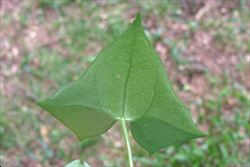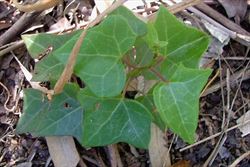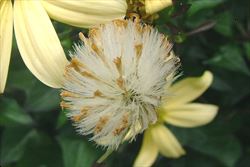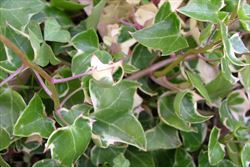Click on images to enlarge

habit (Photo: Sheldon Navie)

stems and ivy-like lobed leaves (Photo: Sheldon Navie)

close-up of leaf underside (Photo: Sheldon Navie)

close-up of flower-head from side-on, showing floral bracts (Photo: Sheldon Navie)

young plant (Photo: Sheldon Navie)

flower-head with several large pale yellow 'petals' (Photo: Sheldon Navie)

close-up of fluffy 'seeds' (Photo: Sheldon Navie)

the leaves of variegated Natal ivy, Senecio macroglossus 'Variegatus' (Photo: Sheldon Navie)
Scientific Name
Senecio macroglossus DC.
Family
Asteraceae (Queensland, New South Wales, the ACT, Victoria, Tasmania, Western Australia and the Northern Territory)Compositae (South Australia)
Common Names
Cape ivy, flowering ivy, German ivy, Natal ivy, wax vine, waxvine
Origin
Native to southern Africa (i.e. Mozambique, Zimbabwe, Lesotho and South Africa).
Naturalised Distribution
Occasionally naturalised in eastern Australia (i.e. in south-eastern Queensland and the coastal districts of northern New South Wales).
Notes
Natal ivy (Senecio macroglossus) is currently regarded as a minor environmental weed in New South Wales, but is also a potential environmental weed in other parts of southern and eastern Australia. This garden escape appears on New South Wales North Coast environmental weed list and is listed as a known environmental weed in Byron Shire.
Natal ivy (Senecio macroglossus) also appears on the list of exotic vines and scramblers that have become established in New South Wales. The invasion and establishment of these species has been determined to be a "key threatening processes" in natural ecosystems in New South Wales. Exotic vines and scramblers have significant adverse effects on biodiversity, as they often smother native vegetation and prevent the recruitment of seedlings.

